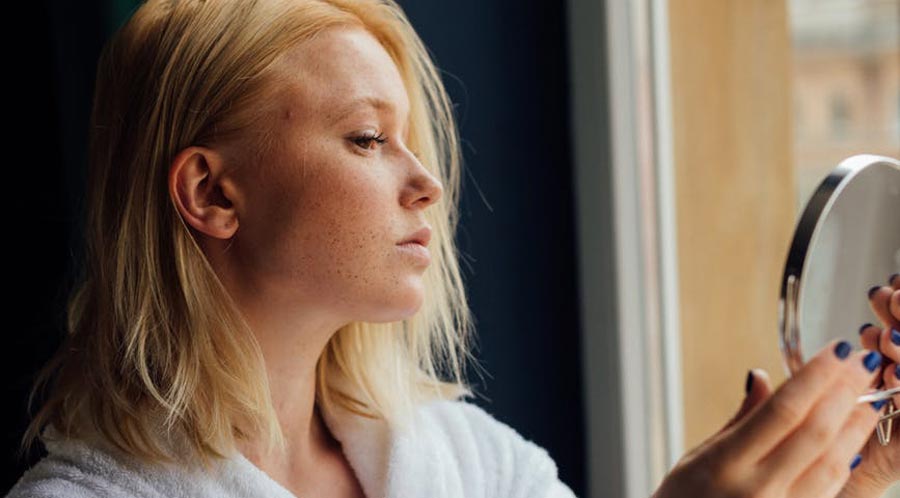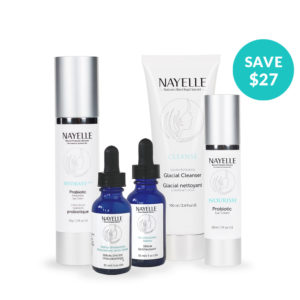Niacinamide and Hypochlorous Acid: How They Treat Severe Acne

Most people would rather forget a few things from their teen years—and acne is no exception. While most of us see pimples as an inevitable part of puberty, adult acne is surprisingly common, particularly among women. Whether you’re suffering from chronic acne, or you break out at certain times of the month, it can be tough to find the right blemish treatment.
Today’s acne treatments are popular, but they can also be hard on the skin, stripping it of its natural moisture. Though you could probably handle it as a teenager, it can present a real challenge to those trying to keep their skin supple and youthful.
Natural treatments often claim to calm or prevent breakouts, but with most, there’s a catch. Either it’s not hydrating enough, or it only works on one kind of breakout. However, we’ve found a couple of ingredients that do it all. In this guide, we’ll discuss the acne-fighting benefits of niacinamide and hypochlorous acid.
Niacinamide: What Is It?
Niacinamide, also called nicotinamide, is one of numerous forms of vitamin B3. It’s naturally found in grains, beans, vegetables, eggs, milk, fish, meat, and yeast, as well as in most B-complex supplements. The human body also makes its own niacinamide using dietary niacin.
Niacinamide is anti-inflammatory and water soluble. It works within the skin to tighten and minimize pores, brighten and balance tone, soften wrinkles and fine lines, and more. Because it strengthens the skin’s natural moisture barrier, it reduces harmful environmental effects while repairing existing damage.
Niacinamide’s Benefits
Niacinamide is a versatile skincare ingredient. It complements existing products, including those with AHAs and BHA, peptides, retinol, vitamin C, and antioxidants. It can even be used with other products containing nicotinamide. No matter your skin type—even rosacea-prone or extremely sensitive—you can use products with niacinamide.
This ingredient boosts the skin’s natural ceramide production, working to restore its barrier against dehydration and moisture loss. With time and poor skincare, these ceramides are depleted, leaving the skin susceptible to dryness and increased sensitivity.
If you already have tight, flaky and dry skin, apply a niacinamide product along with a moisturizer for additional hydration. These products work well with moisturizing ingredients such as plant oils, glycerin, sodium hyaluronate, and cholesterol.
How Does it Work?
The precise mechanism by which niacinamide works is not known. One thing researchers do know is that nicotinamide shrinks pores, helping them return to their true size and decreasing the risk of blockage. Enlarged pores occur when debris builds up or when sun damage occurs, but niacinamide products tighten pores by replenishing supportive elements within the skin. Research even shows that products containing 2% or more niacinamide can help fade red, swollen skin blemishes such as those caused by acne.
Is It Safe to Use Niacinamide Around the Eyes?
Yes! Our niacinamide-containing products can be used with your eye cream or moisturizer to soften the look of fine lines and wrinkles, brighten under-eye dark circles, and prevent moisture loss, leaving the skin looking younger and brighter. For maximum protection, use a broad-spectrum sunscreen of SPF30 or more.
Hypochlorous Acid: A New Acne-Fighting Skincare Ingredient
It’s an acid that’s both tough enough to kill viruses—including the virus that causes COVID-19—and mild enough to use on facial acne. While it may seem like an impossibility, the acne-fighting benefits of hypochlorous acid are real. We’ll discuss these advantages in the sections below.
What Is Hypochlorous Acid, Anyway?
Hypochlorous acid naturally exists in the human body. It’s created by the white blood cells as a defense against bacteria, germs, and infection. It attacks pathogens, breaking down their cell walls before destroying them completely.
Because the body makes it naturally, why is it now a common ingredient in cleaning supplies and skincare products? The answer is a simple one: chemists figured out how to make it by breaking down a saltwater solution with electrolysis. Recently, however, technological advances have allowed the large-scale production of hypochlorous acid.
Hypochlorous Acid and Acne: The Benefits
Skin is durable and resilient, which helps it fulfill its role as one of the human body’s largest and most important organs. It’s the body’s first line of defense against viruses and other contaminants, but it’s also vulnerable. Hypochlorous acid helps the skin by:
- Fighting the bacteria that cause acne
- Repairing damage and accelerating healing
- Reducing the inflammation caused by psoriasis, eczema, and other conditions
Best of all, because it’s naturally produced by the immune system, hypochlorous acid is incredibly mild and gentle. It’s a great choice for those with sensitive skin because it doesn’t create the irritation, burning, dryness, or itching of other products.
Use Hypochlorous Acid and Niacinamide As Part of Your Skincare Routine
Now that you’ve learned about the acne-fighting benefits of hypochlorous acid and niacinamide, it’s time to get started on the path to radiant, clear skin. Count on the skincare experts at Nayelle to help you create a routine that leaves you feeling happy and healthy.

